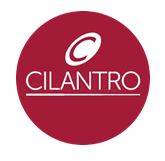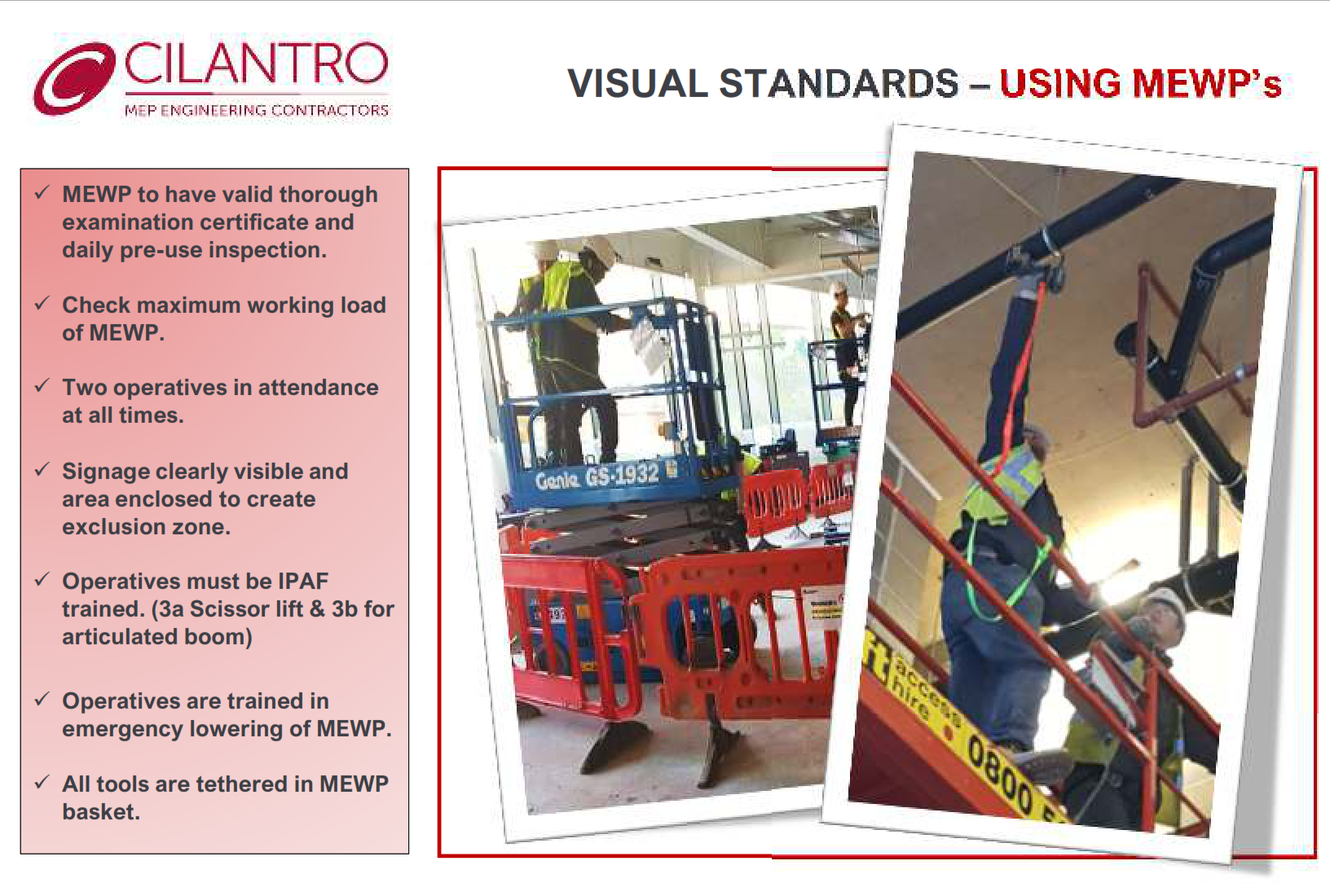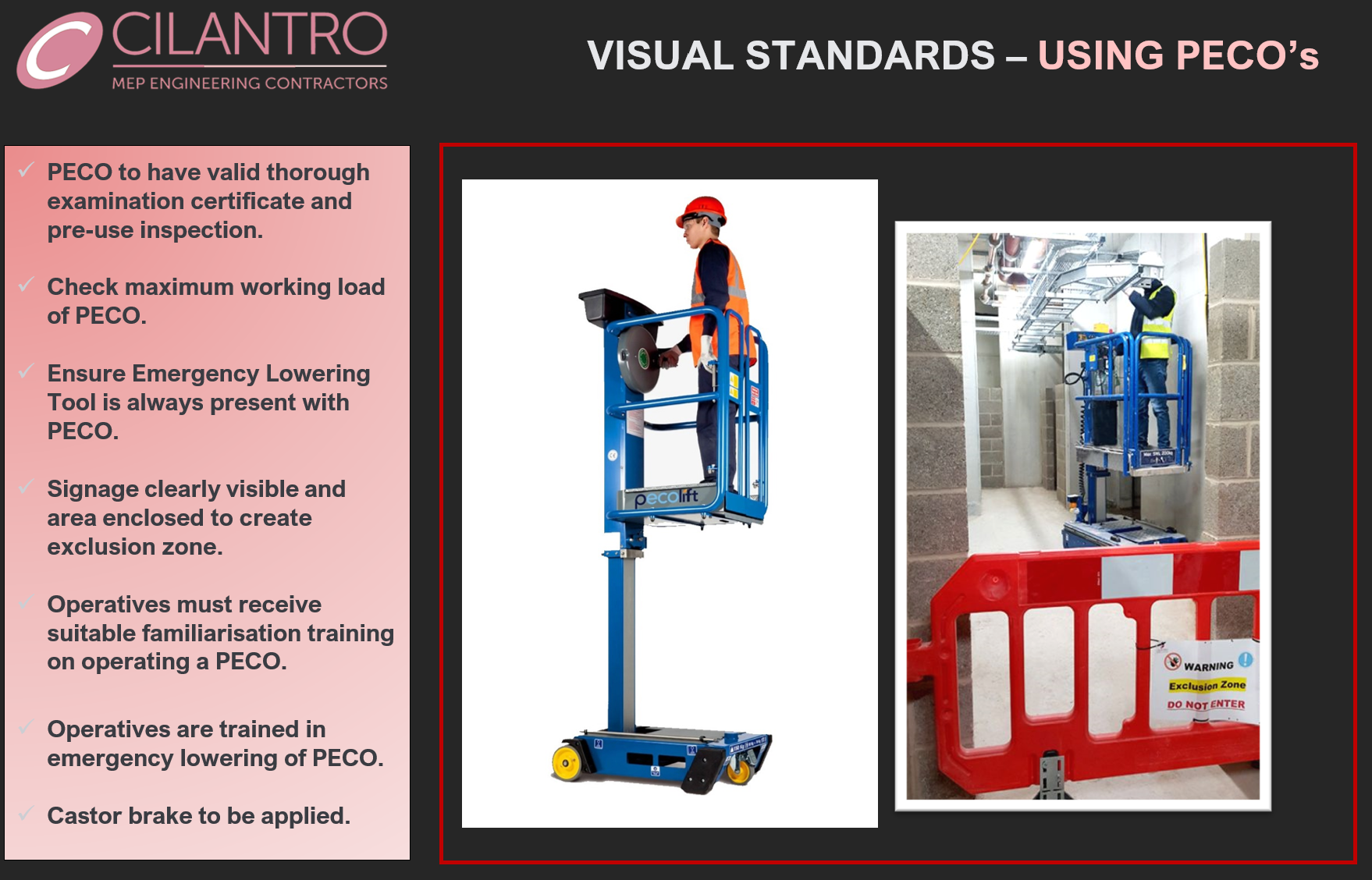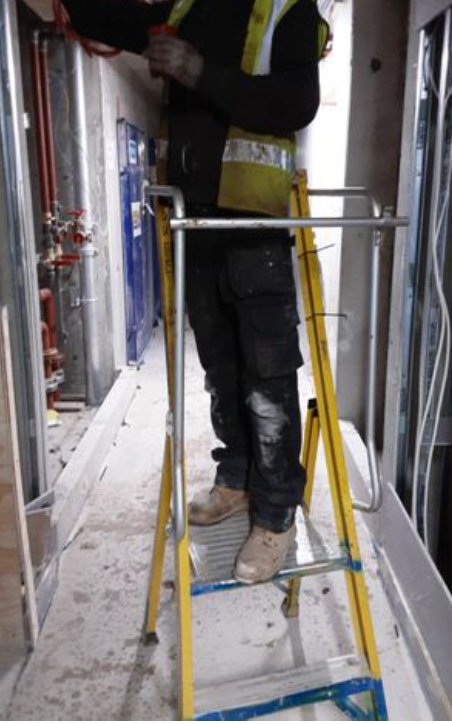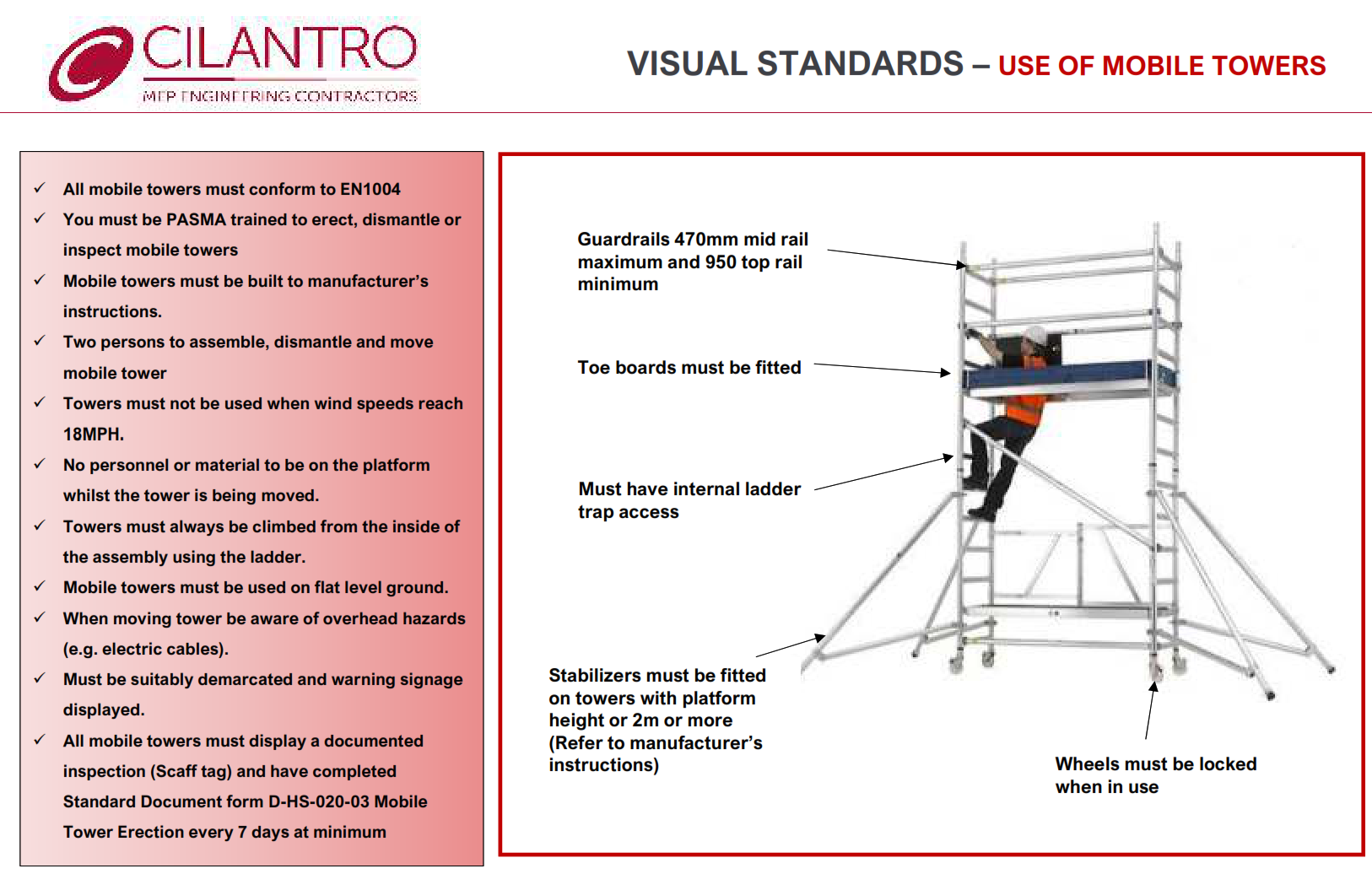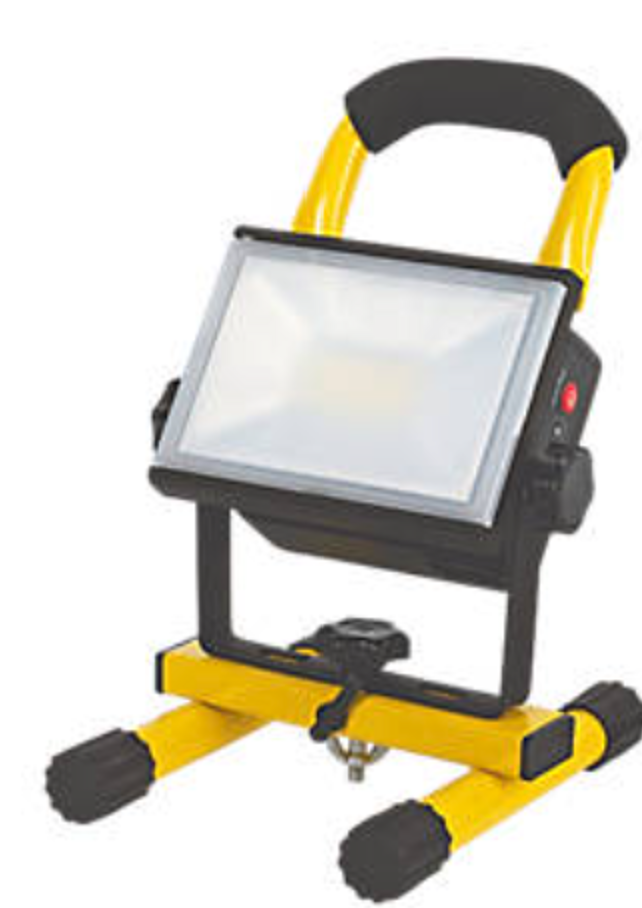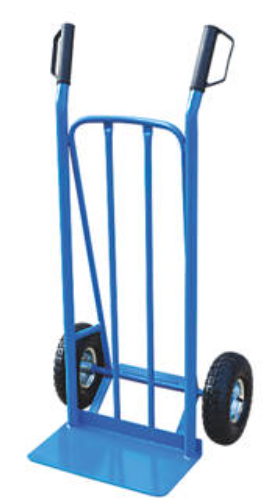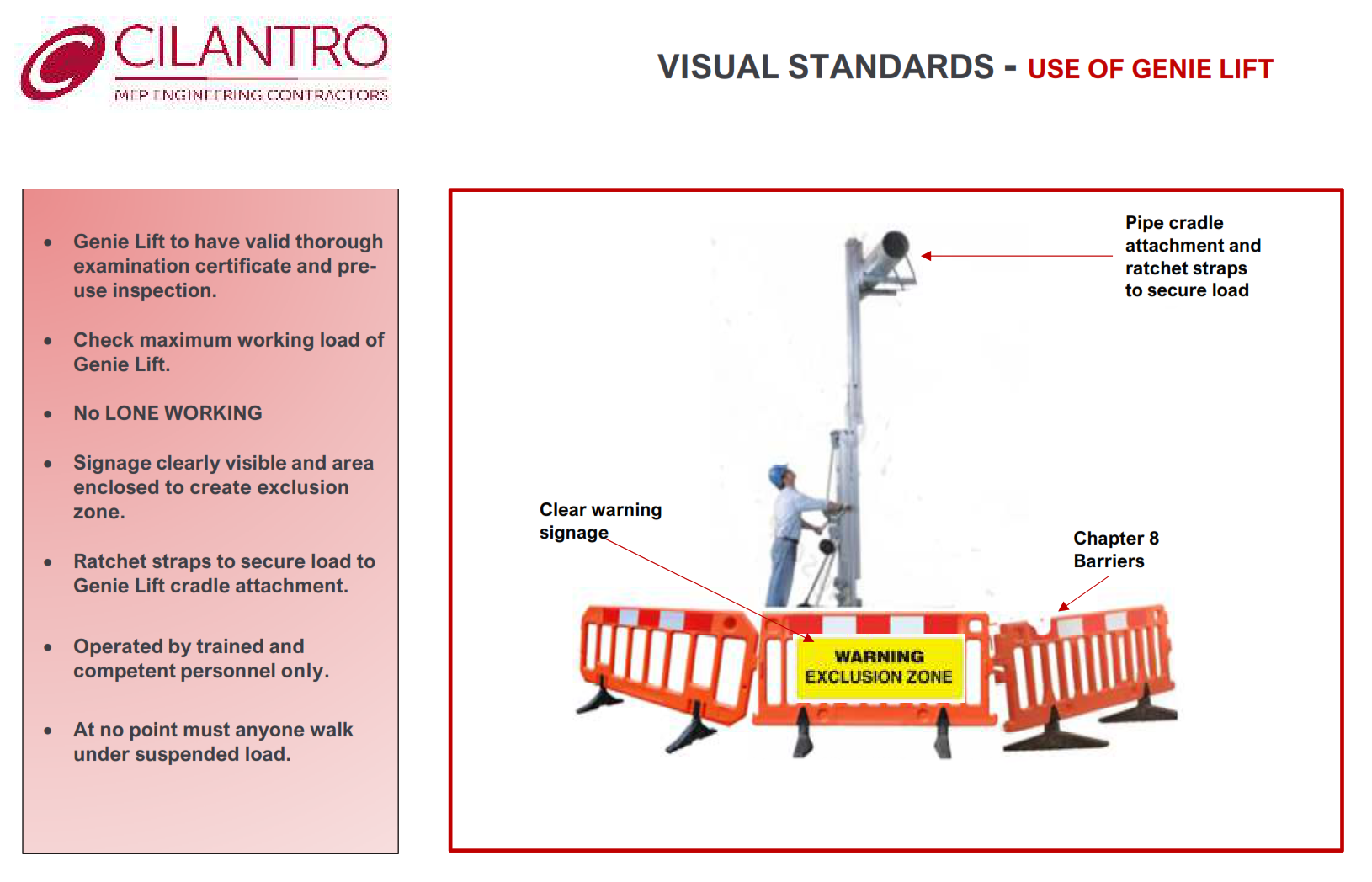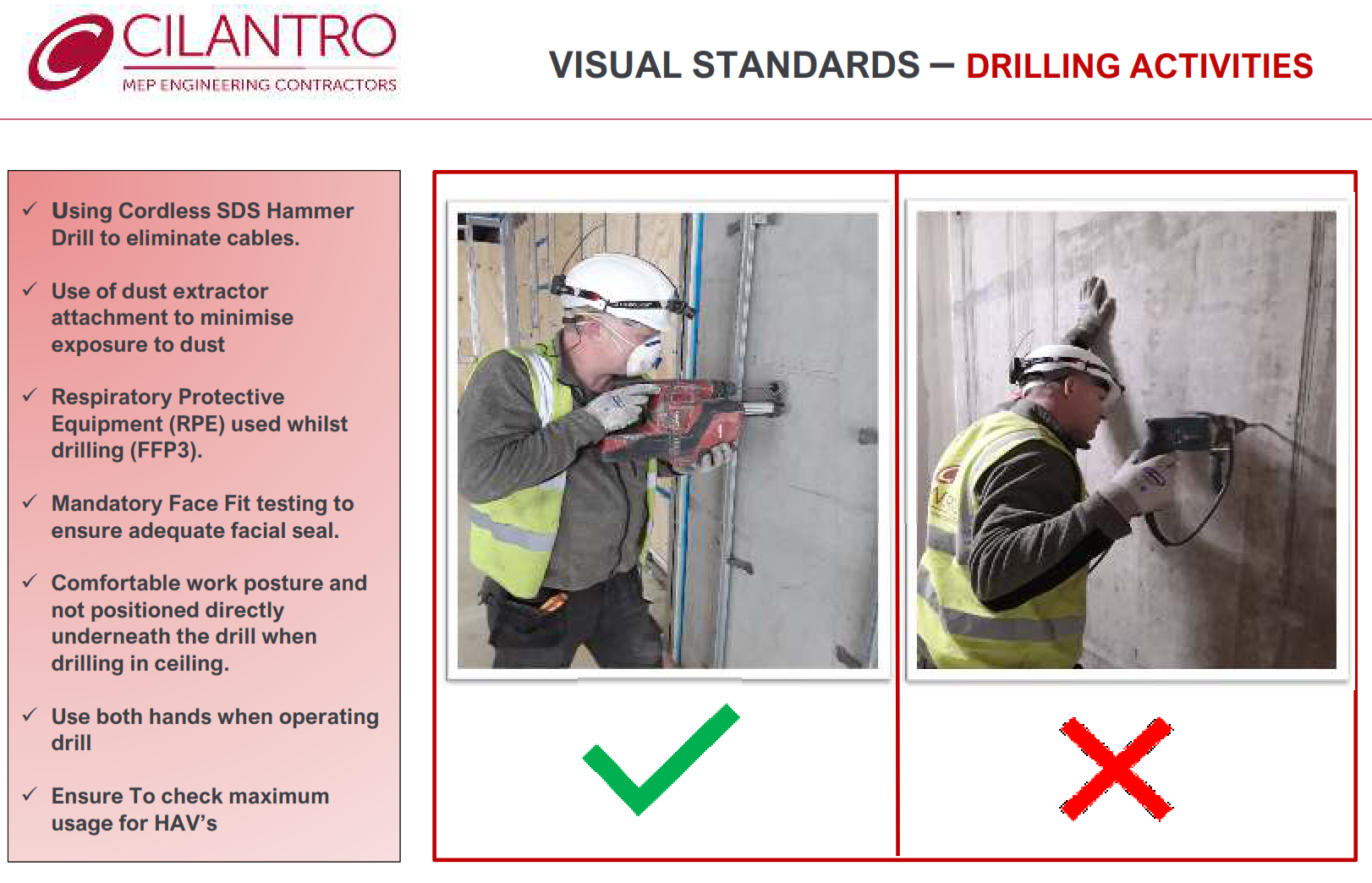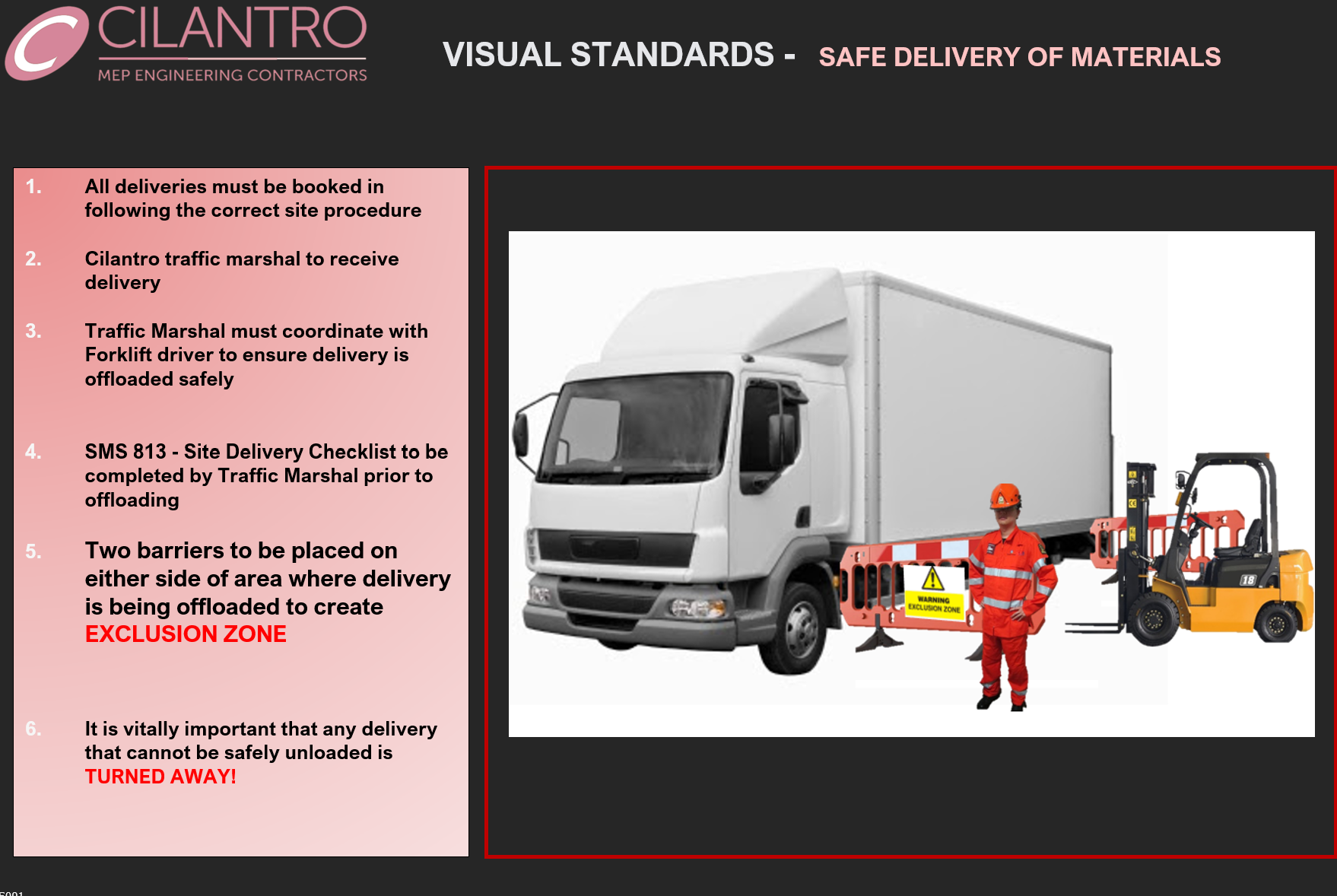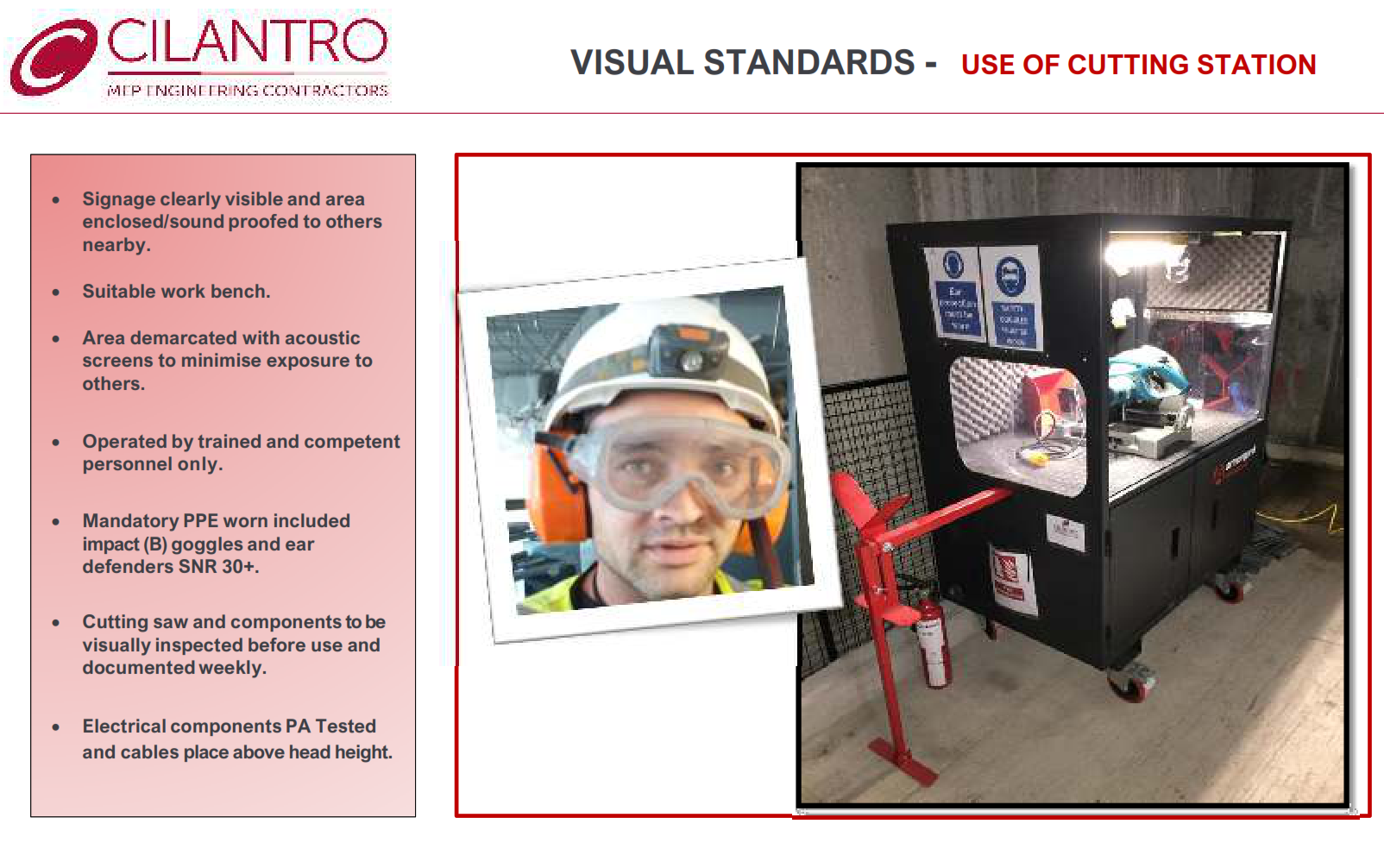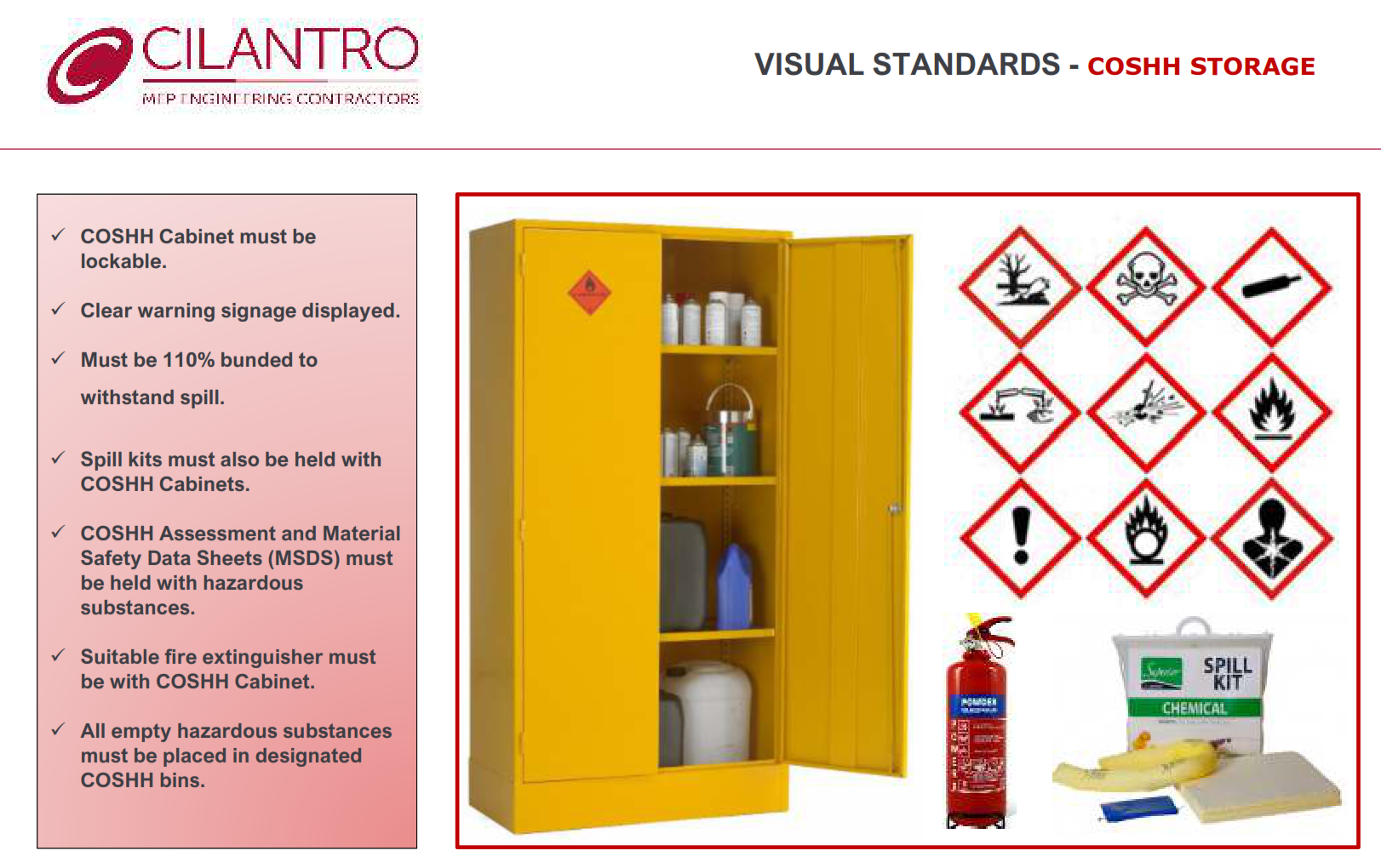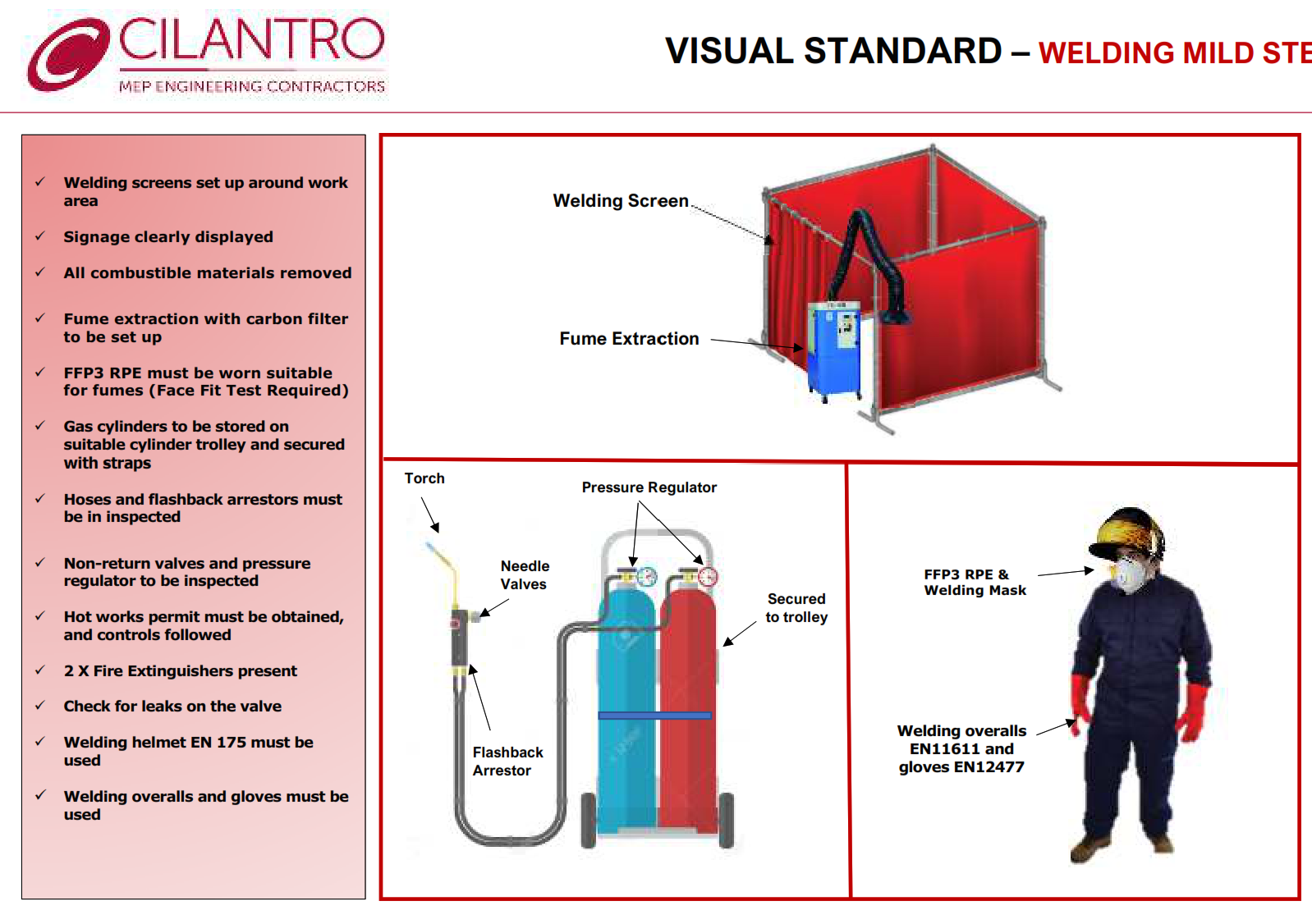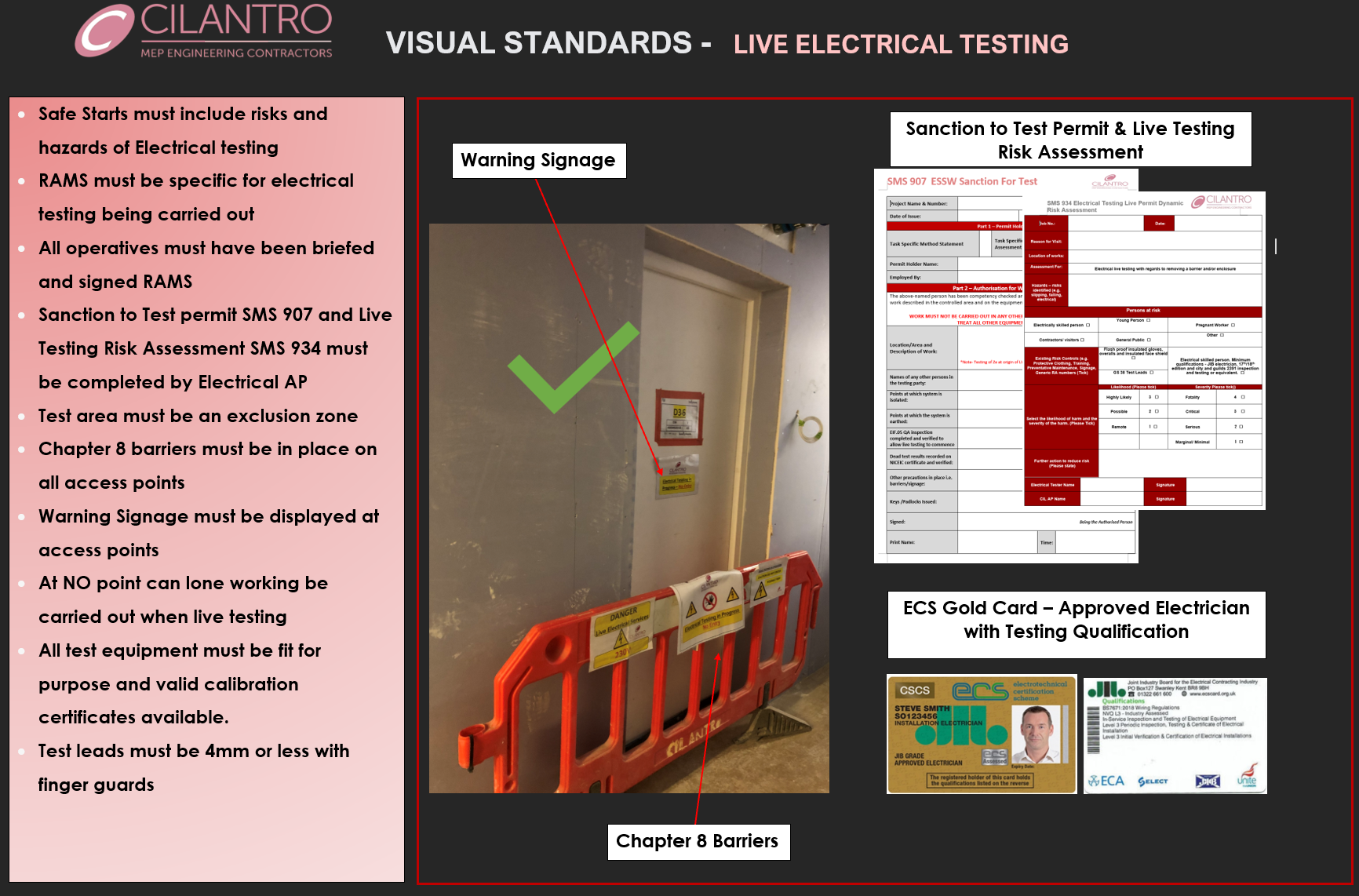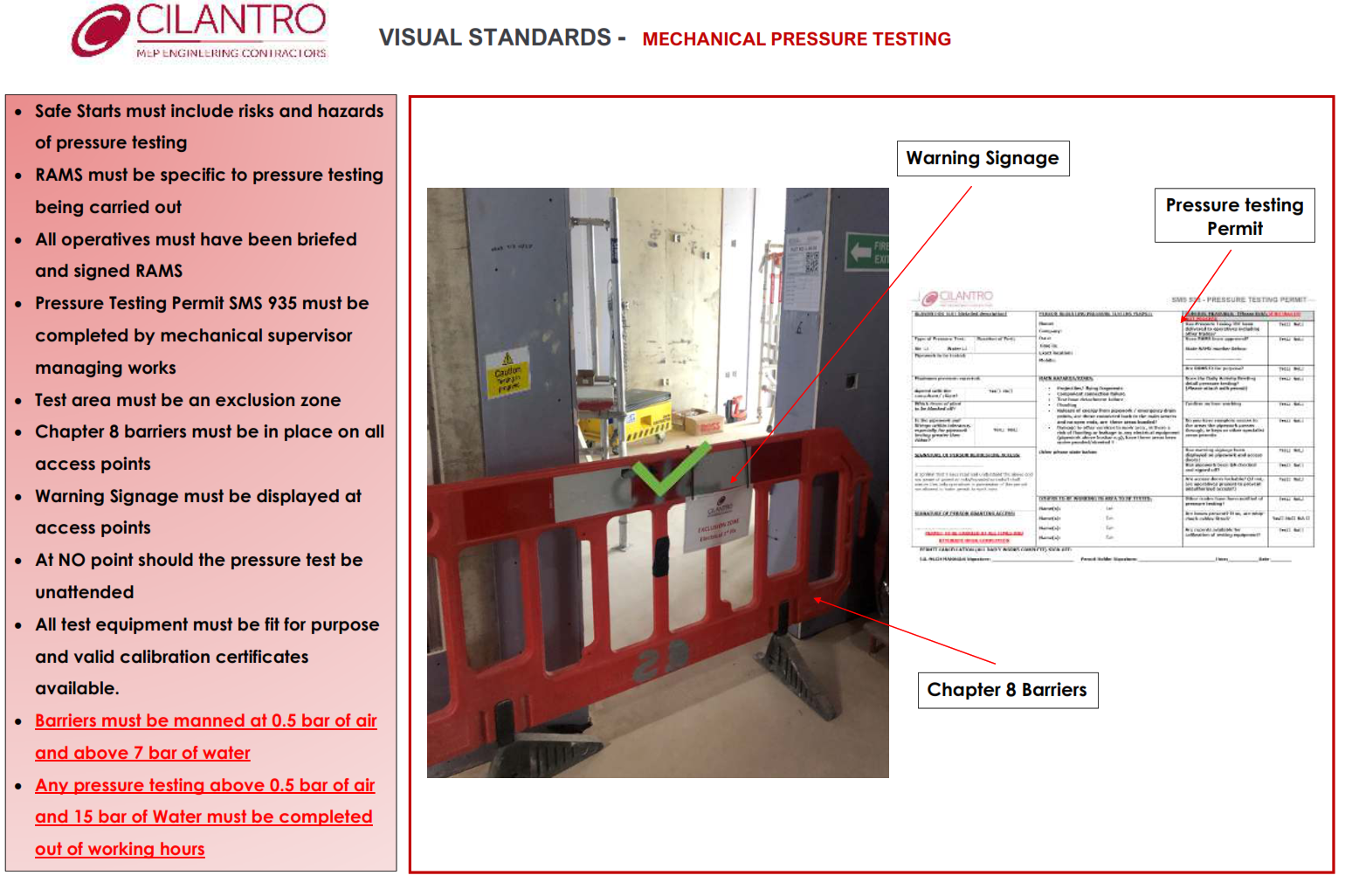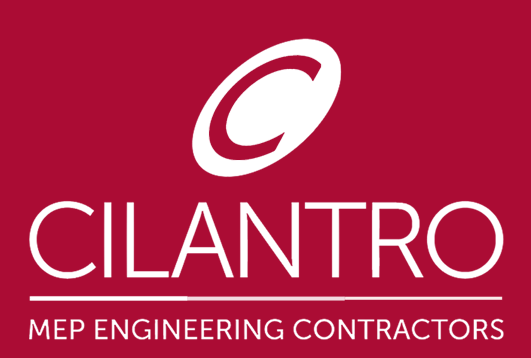Title Page
-
Conducted on
-
SSSTS Supervisor name
-
Sub-contractor
-
Location
-
Location (Block/Level/Apartment)
Safe Working Environment
-
Do you have 1-8 Supervisor ratio?
-
Please upload certificate
-
State RAMS Number for tasks being carried out?
-
Have you inspected all plant and equipment? (visual and documented inspections)
-
Confirm safe access/ egress to work area. (if NO then contact Cilantro Supervisor)
-
Do you have sufficient barriers and warning signage in your work areas?
-
Do you need to use task lighting? If so, please ensure operatives are issued adequate lighting.
-
Do you need a permit to work? Select permits needed (Cilantro AP to issue)
- N/A
- Limitation of Access Electrical
- Limitation of Access Mechanical
- Sanction to Test
- Hot Works
- Step Ladder Permit (Last Resort)
- Hop up (Last Resort)
- OTHER (Please state)
-
Other permits (Please state)
Power Tools - HAV/ Noise/ Dusts
-
Will you be using power tools?
-
Hammer Drill - 30 mins use MAX - use dust extraction, FFP3 RPE and ear protection
-
Chop Saw - 3 Hours use MAX - Use safety goggles and ear protection
-
Impact Driver - 30 minutes use MAX - Use ear protection
-
Angle Grinder - 36 minutes MAX - Use safety goggles and ear protection
-
Combi Drill - 15 minutes MX (Concrete) use dust extraction, FFP3 RPE and ear protection
-
Reciprocating Saw - 11 minutes use MAX - use hearing protection
-
Paslode Spit Gun - 3 hours 10 minutes use Max - Use safety goggle and hearing protection
-
Multi Tool - 20 minutes use MAX - Wear hearing protection
-
Jigsaw - 36 minutes use MAX - Wear hearing protection
-
undefined
What hazards are present?
-
Working from MEWP (IPAF needed)
-
- MEWPs to be operated by competent IPAF trained persons only.
- A thorough examination must be in date
- Daily documented inspection
- Ensure chapter 8 barriers and warning signage is displayed
- A second competent person to be present in case of an emergency.
- Use on firm level ground
- Do not exceed SWL of platform
- Tools to be tethered as per Cilantro’s Tethering Policy.
- MEWP rescue plan to be in place
- Keys must be removed and stored in a secure place, and MEWPs disconnected from the power when not in use -
Working from Peco Lift?
-
- PECOs are to have a documented weekly inspection completed prior to use by a competent person.
- PECO Thorough Examination of Equipment to be held on file.
- Familiarise with the manufacturer’s instruction manual.
- Emergency Lowering Tool must be in place
- Brief operators on the dangers if confined overhead working.
- The platform is to be kept tidy at all times and used on firm and level ground.
- Do not stand on mid guard rails -
Working from Podium (PASMA needed)
-
- All podium steps used on site must be PAS 250/BS 8620 compliant.
- Podiums to be inspected and signed off by a competent PASMA trained person every seven days
- Do not overreach on podium
- Wheels must be locked
- Stabilisers must be in place and gate closed -
Mega Step (PASMA needed)
-
- Mega Step to be inspected and signed off by a competent PASMA trained person every seven days
- Do not overreach on Mega Steps
- Chain must be attached when working on Mega Step Platform -
Delta Deck (PASMA needed)
-
- Delta Decks are to be inspected and signed off prior to first use by a competent PASMA trained person and every seven days.
- The inspection shall include as a minimum checking locking mechanisms, access gate, joints and locking pins to be checked for damage.
- A scaff-tag MUST be attached and signed off by a competent person.
- Operatives shall not overreach especially laterally from Delta Deck -
Mobile Tower (PAMSA required)
-
- All access towers will be erected, modified, or dismantled by or under the supervision of a competent person who will hold a PASMA certificate.
- Must be inspected every 7 days at minimum by a PASMA trained operative
- Access equipment to be assembled with the top guard rails set a 950 minimum above the working platform, no unprotected gap greater than 470mm for the mid guard rail and toe boards must be fitted.
- Stabilisers to be fitted
- Wheels must be locked
- Climb ONLY through the hatch door internally to working platform level. Do not climb outside of the tower.
- Under No circumstance are operatives or materials to remain on any part of the access tower whilst being pushed to a new location.
- The height of the access tower is to be reduced to 4 meters prior to moving to a new location. -
Working from step ladder - LAST RESORT (Permit required)
-
- Step ladders must be used as last resort (UNDER PERMIT) and for short duration only
- Step ladders are to be inspected and signed off by a competent PASMA trained person and every seven days thereafter. A scaff tag must be signed off and attached by the inspector.
- Ladders are to have a daily check sheet completed prior to use.
- All stepladders must be EN/BS 131 compliant for "professional" use
- Ensure stepladders are in good condition and fully open before use. Do not use any stepladder with damaged or defective parts.
- Do not stand on top 3 treads of step ladder -
Working from Hop up? LAST RESORT (Permit required)
-
- Hop ups are to be inspected and signed off by a competent PASMA trained person and every seven days.
- A scaff tag must be signed off and attached by the inspector.
- Use industrial grade 400mm high hop up platforms minimum 600mm X 600mm wide.
- Work durations to be kept short
- Only to be used if not possible to use step ladder -
Poor lighting in work area?
-
Use task lighting where there is poor lighting in work area. Do not attempt to work in areas with poor lighting.
-
Manual Handling
-
- Use mechanical aids (Pallet truck/ Trolleys) to transport materials
- Where mechanical aids cannot be used, manual handling exercise shall be limited, with task rotation utilised where necessary.
- Team lifting is to be undertaken for all large or awkward weights.
- Utilise TASK, LOAD, INDIVIDUAL, ENVIRONMENT -
Poor housekeeping
-
- Ensure to clean as you go
- Remove excess build up of materials to minimise trip hazards.
- All tools and materials should be stacked, stored and sealed out of pedestrian routes -
Lifting using Genie Lift?
-
- YOU MUST BE trained in use of Genie Lift.
- Genie Lift to be used only for lifting materials.
- A thorough examination must be in place and in date
- A lift plan must be in place prior to works being carried out.
- All Genie Lift components to be visually inspected prior to use (refer to manufacturer’s instructions) and a documented record completed.
- Use on firm level ground, capable of withstanding the load.
- Materials will be strapped to Genie Lift forks using Ratchet Straps.
- Ensure the load is evenly distributed and within the manufacturer’s SWL.
- Ensure area is appropriately cordoned off with warning signage displayed to prevent people below being struck by falling objects.
- Do not stand under or allow personnel under the machine when the load is raised.
- Genie Lift will be moved to work locations by 2 operatives.
- DO NOT move the Genie Lift with a raised load. -
Drilling operations
-
- Use dust extraction drills - Wear eye protection EN 166 and ear plugs EN 352 SNR 30+.
- FFP3 respiratory protection must also be worn to avoid any adverse effects to their health from dust created.
- A face fit test will be carried out for anyone using RPE a
- All use of drilling tools and equipment must be carried out as per the CILANTRO HAV & Noise Register.
- All tools to be visually inspected prior to use, a weekly documented inspection and a valid PAT sticker within the past 3 months. -
Working around other trades?
-
- Ensure to coordinate so you works do not impeded on other trades
- Set up barriers and signage to let other trades know of your works
- keep your work area tidy and do not block escape routes -
Vehicle deliveries to site?
-
- Drivers will not exit their vehicles unless they are wearing full site PPE
- Banksman must instruct driver
- Unloading shall be carried out by mechanical means where possible.
- Follow Cilnatro Delivery procedures
- Once unloaded, all materials will be manually distributed to the designated storage area
- At no time, will any operative attempt to carry out lifting of any materials which are beyond their own personal capabilities.
- Pallet trucks and other mechanical means to be utilised
- Assess weather conditions and working environment before carrying out any manual handling tasks. In icy conditions ensure that areas are suitably and regularly gritted/salted to reduce the risk of slipping. -
Occupational health? (Noise, Dust, Vibration?)
-
- Follow HAV and Noise register trigger times - Select the lowest vibration tool for task
- Wear hearing protection SNR 30+ and enclose activity to reduce exposure top others
- Clear all personnel from work area before raising or lowering the platform.
- Wear FFP3 RPE when drilling or exposed to dusts - Face fit test required -
Cutting materials (Chop saw, skill saw, recip saw)
-
- Use cutting station to enclose cutting activity
- Set up barriers and warning signage alerting others of cutting activities
- Daily visual inspection must be carried out and weekly documented inspection on Weekly Tool Inspection Form.
- Clear all personnel from work area before raising or lowering the platform.
- All 110v equipment to be PAT tested within 3 months - Safety goggles and ear protection must be worn when carrying out cutting activities -
Sharp Objects (Plasterboard studwork, unistrut, threaded bar)
-
- Inspect work area prior to starting work
- Ensure to wear minimum cut 3 safety gloves
- If working in ceiling or in wall, wear kevlar sleeves -
Hazardous substances
-
- Attend to and maintain high standards of personal hygiene.
- All COSHH items must be sealed when not in use and placed back in COSHH cabinets.
- COSHH waste must be disposed of in designated COSHH bins held on site.
- Wear PPE/ RPE stated in COSHH Assessment (Within RAMS) -
Live electrical & Mechanical systems
-
- Follow Cilantro mechanical & electrical safety procedures
- Cilantro AP to isolate/ energise only
- If access to risers, plant rooms or LV rooms are required, contact Cilantro AP
- Do not tamper with any live mechanical or electrical system -
Using abrasive wheels
-
- Trained in using abrasive wheels
- Wear safety goggles and hearing protection
- Check that wheel is not damaged, expiry date has not been exceeded and there is no contamination of the wheel - Visual and documented inspection must be carried out on Cilantro inspection form - Ensure material to be cut is secured in vice clamp - Fully inspect grinder - The handle and guard must be attached to grinder and use 2 hands to cut with grinder -
Welding
-
- Use fume extraction with carbon filter when welding
- FFP3 respirator to also be used which requires a face fit test certificate
- Suitable gloves, protective clothing and eye protection may also be appropriate for certain work where splashing of fluxes etc.
- Use the correct lighting-up procedure. Purge the hoses before lighting the torch to remove any potentially explosive gas mixtures. Use a spark igniter and light the gas quickly after turning it on.
- Make sure the blowpipe is fitted with spring-loaded non-return valves.
- Use the correct gas pressures and nozzle size for the job.
- Maintain the equipment in good condition. These measures will reduce the risk of a flashback but will not completely eliminate it. Non-return valves will not stop a flashback once it has occurred.
- Welding screens to be erected to prevent others coming into work area and exposure to weld flash. Operatives within work area to wear welding mask, Welding Apron and welding gloves.
- All gas bottles must be stored correctly in the gas cage, e.g. upright position, securely restrained to prevent falling over, away from direct sunlight and at safe distance (at least 3m away) from toxic, corrosive, combustible materials, flammable liquids, ignition sources and general waste.
- Gas cage must be stored in open air or a well-ventilated area.
- Oxygen cylinders must be stored at least 3m away from flammable gas cylinders.
- Suitable Fire extinguishers must be located next to works.
- Gas cylinders must be returned to the gas cage on completion of works/at the end of the day.
- Gas cylinders to be transported on a cylinder trolley, in upright position and secured to prevent falling over.
- Gas cylinders must not be left on site unattended.
- Gas cylinders must be disconnected when not in use.
- Gas cage must be locked at all times to prevent unauthorised access and signage must be displayed. -
Soldering pipe
-
- Hot work permit must be in place - Remove all combustible materials or cover with fire retardant sheet - Barrier off area and display warning signage - Have 2 suitable fire extinguishers next to works - Full PPE must be worn - If soldering above head height then safety goggles must be worn - YOU MUST carry out 1 hour fire watch
-
Electrical Testing
-
- You must have ECS Gold Card Approved Electrician - Obtain permit from Cilantro AP - Only Cilantro AP top isolate and energise systems - Multifunction Tester must have in date calibration certificate - 4mm max test probes - If live testing then only test at Consumer unit is Zs and PFC - Cover must be placed on and all other tests carried out in the field
-
Pressure Testing
-
- Permit must be obtained is testing 0.5 air or above 7 bar water - Test gauge must have valid calibration certificate available - Area must be exclusion zone where test is being carried out - Barriers and warning signage must be on entry points to prevent unauthorised access to exclusion zone - Pressure test must not be left unattended - Pipework must not be left under test over night
Sign off as conformation of briefing
-
Supervisor 1 Signature
-
Add signature
-
Operative 1 signature
-
Add signature
-
Location:
-
Activities being carried out:
-
Operative 2 signature
-
Add signature
-
Location:
-
Activities being carried out:
-
Operative 3 signature
-
Add signature
-
Location:
-
Activities carried out:
-
Operative 4 signature
-
Add signature
-
Location:
-
Activities being carried out:
-
Operative 5 signature
-
Add signature
-
Location:
-
Activities being carried out:
-
Operative 6 signature
-
Add signature
-
Location:
-
Activities being carried out:
-
Operative 7 signature
-
Add signature
-
Location:
-
Activities being carried out:
-
Operative 8 signature
-
Add signature
-
Location:
-
Activities being carried out:
-
Need another SSSTS supervisor added?
- Yes
- No
- N/A
-
SSSTS Supervisor Name
-
Operative 1 signature
-
Add signature
-
Location:
-
Activities being carried out:
-
Operative 2 signature
-
Add signature
-
Location:
-
Activities being carried out:
-
Operative 3 signature
-
Add signature
-
Location:
-
Activities carried out:
-
Operative 4 signature
-
Add signature
-
Location:
-
Activities being carried out:
-
Operative 5 signature
-
Add signature
-
Location:
-
Activities being carried out:
-
Operative 6 signature
-
Add signature
-
Location:
-
Activities being carried out:
-
Operative 7 signature
-
Add signature
-
Location:
-
Activities being carried out:
-
Operative 8 signature
-
Add signature
-
Location:
-
Activities being carried out:
-
Need another SSSTS supervisor added?
- Yes
- No
- N/A
-
SSSTS Supervisor Name
-
Operative 1 signature
-
Add signature
-
Location:
-
Activities being carried out:
-
Operative 2 signature
-
Add signature
-
Location:
-
Activities being carried out:
-
Operative 3 signature
-
Add signature
-
Location:
-
Activities carried out:
-
Operative 4 signature
-
Add signature
-
Location:
-
Activities being carried out:
-
Operative 5 signature
-
Add signature
-
Location:
-
Activities being carried out:
-
Operative 6 signature
-
Add signature
-
Location:
-
Activities being carried out:
-
Operative 7 signature
-
Add signature
-
Location:
-
Activities being carried out:
-
Operative 8 signature
-
Add signature
-
Location:
-
Activities being carried out:
